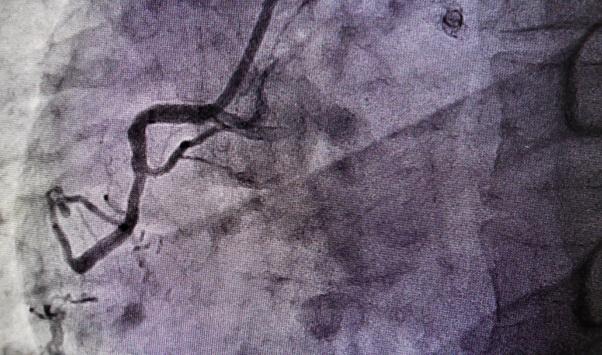Benefits of FFR-Guided Complete Revascularization in STEMI May Be Limited to Most Severe Disease
Whether revascularization can be waived in patients without high-risk criteria awaits hard-outcomes data from ongoing trials, experts say.

The severity of disease in nonculprit arteries seems to influence how much of an advantage fractional flow reserve (FFR)-guided complete revascularization has over treatment of the culprit artery only in patients undergoing primary PCI for STEMI, a post hoc analysis of the DANAMI3-PRIMULTI trial suggests.
The main trial results showed that FFR-guided treatment of flow-limiting nonculprit lesions in a staged fashion reduced the primary composite endpoint of all-cause mortality, reinfarction, and ischemia-driven revascularization, driven by an effect on revascularization but not the other outcomes. This new analysis, however, shows that the reduction is seen only in patients with three-vessel disease combined with nonculprit stenoses of at least 90%. That group makes up about 16% of the trial cohort.
“These patients represent a high-risk population in whom FFR-guided complete revascularization should be considered, whereas it seems safe to waive revascularization in the patients who do not meet these criteria,” lead author Jacob Lønborg, MD, PhD (Rigshospitalet, University of Copenhagen, Denmark), and colleagues write in the April 2017 issue of Circulation: Cardiovascular Interventions. “Future prospective trials should confirm these findings.”
The value of complete revascularization in patients undergoing primary PCI continues to be debated, although there are accumulating data—from trials like PRAMI, CvLPRIT, DANAMI3-PRIMULTI, and Compare-Acute—supporting treatment of nonculprit disease, either at the time of the index procedure or in a staged fashion.
There remains uncertainty, however, about how the results should be incorporated into clinical practice, making it relevant to explore whether there are groups of patients who are more likely to derive a benefit from the approach, the authors say.
In this substudy of DANAMI3-PRIMULTI, the investigators explored the impact of the number of diseased vessels, lesion location, and severity of nonculprit stenoses on the effects of FFR-guided complete revascularization. The 627 patients in the trial were randomized to FFR-guided treatment of nonculprit lesions 2 days after PCI of the culprit artery only or to treatment of the culprit artery alone. Over a median follow-up of 23 months, 17% had a primary endpoint event.
Lønborg et al found that patients with three-vessel disease—but not those with two-vessel disease—had improved outcomes with complete revascularization (P = 0.046 for interaction). Similarly, patients with stenoses of at least 90% in nonculprit arteries—but not those with less severe narrowing—tended to derive a benefit (P = 0.06 for interaction). Location of nonculprit disease (proximal or distal) did not interact with the effects of the intervention.
When the patients were divided into four groups based on the number of diseased vessels and the degree of stenosis in nonculprit arteries, FFR-guided completed revascularization reduced the primary endpoint only in patients with three-vessel disease and nonculprit stenoses of at least 90% (8% vs 41%; HR 0.13; 95% CI 0.05-0.39). The components of the endpoint, as well as all secondary outcomes, were numerically less frequent with more complete treatment, but the difference reached statistical significance only for ischemia-driven revascularization.
Awaiting a More COMPLETE Answer
In an accompanying editorial, David Wood, MD (University of British Columbia, Vancouver, Canada), and colleagues point out that even in that highest-risk subgroup, there was no significant reduction in death or MI. That’s consistent, they add, with the larger Compare-Acute trial, which also showed that the use of FFR-guided complete revascularization reduced a composite endpoint, with the difference driven by a lower rate of repeat procedures.
“Although repeat revascularization may be an important outcome from a patient perspective, its importance in the absence of a reduction in hard outcomes such as death or MI is debatable,” the editorialists write, noting that none of the published RCTs in this area have been powered to detect meaningful differences in long-term death or MI.
They point out that the COMPLETE trial, which has recently reached its enrollment target with 4,402 STEMI patients randomized to either staged complete revascularization or treatment of the culprit artery only, is powered for hard clinical outcomes.
That trial “will provide the crucial safety data that is so desperately needed before clinicians can make informed decisions with their patients,” Wood et al write. “In the meantime, we recommend thoughtful consideration before fully embracing the results of these small trials until we have the COMPLETE answer.”
Lønborg and colleagues agree that “the optimal strategy for treatment of noninfarct-related stenosis in STEMI patients with multivessel disease remains uncertain, and forthcoming large randomized studies will hopefully shed further light on this issue.”
Todd Neale is the Associate News Editor for TCTMD and a Senior Medical Journalist. He got his start in journalism at …
Read Full BioSources
Lønborg J, Engstrøm T, Kelbæk H, et al. Fractional flow reserve-guided complete revascularization improves the prognosis in patients with ST-segment-elevation myocardial infarction and severe nonculprit disease: a DANAMI 3-PRIMULTI substudy (Primary PCI in Patients With ST-Elevation Myocardial Infarction and Multivessel Disease: Treatment of Culprit Lesion Only or Complete Revascularization). Circ Cardiovasc Interv. 2017;10:e004460.
Wood DA, Cairns JA, Mehta SR. Multivessel revascularization and ST-segment-elevation myocardial infarction: do we have the complete answer? Circ Cardiovasc Interv. 2017;10:e005215.
Disclosures
- The study was supported by the Danish Agency for Science, Technology, and Innovation and the Danish Council for Strategic Research.
- Lønborg reports no relevant conflicts of interest.
- The editorialists report receiving grant support from AstraZeneca and Boston Scientific.


Comments